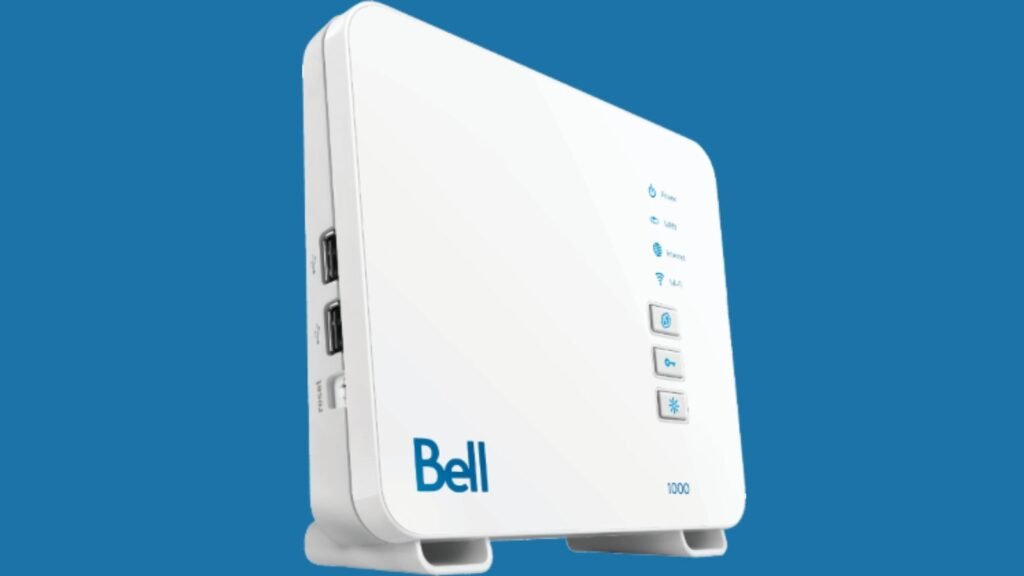Having fast and reliable internet is super important for everything we do online. If you use the Bell fiber speed test, testing your internet speed and making sure your modem works well can make a big difference. This guide will show you how to check your Bell Fibe speed with different modems, understand what the results mean, and fix any speed problems. We’ll make it easy to understand, so you can enjoy a smoother and faster internet experience with Bell Fibe. Let’s get started!
Table of Contents
ToggleModems
What is a Modem?
A modem is a device that helps your computer or phone connect to the internet through things like phone lines or cables.
It changes the signals so your devices can talk to the internet.
In simple terms, think of a modem as a bridge that lets your devices talk to the internet using the right language.
Types of Modems Bell Fibe Uses
DSL Modems: These are for internet connections that use telephone lines. Bell Fibe often uses this type.
Fiber Optic Modems: They work with super-fast fiber optic internet, which Bell Fibe also offers in some areas.
Cable Modems: These connect to cable lines and are used where Bell Fibe provides internet through cables.
Modem-Router Combos: Sometimes, Bell Fibe gives you a device that’s both a modem and a Wi-Fi router. It makes setting up the internet at home easier.
Knowing these modem types is handy because they affect how fast and reliable your internet connection is.
Getting Ready for the Test
Making Sure Your Modem is Set Up Right Before you check your internet speed with different modems from Bell Fibe, it’s important to set up your modem correctly. Here’s how:
Plug in Everything: Make sure all the cables are connected properly to your modem and the right outlets.
Turn on Your Modem: Check that your modem is switched on and the lights on it look normal.
Update Your Modem: If there are updates available for your modem’s software, install them. This can improve how well your modem works.
Find a Good Spot: Put your modem in a central place in your home or office to get the best Wi-Fi coverage.
Check Wi-Fi Settings: If your modem has Wi-Fi, set up a strong password and pick the best channel to avoid problems.
Doing these steps right makes sure your modem works well for the speed test and gives accurate results.
Making Sure Your Internet Stays Strong Another important thing before the speed test is to have a stable internet connection. Here’s what to do:
Ping Test: Test how fast your internet responds. A fast response is good for things like games and video calls.
Check What’s Using Bandwidth: Make sure no big downloads or uploads are happening during the test. It’s better to test when the internet is not too busy.
Avoid Interference: Keep your modem away from things like microwaves or cordless phones that might mess up your Wi-Fi.
Keep a Strong Signal: If you’re using Wi-Fi, make sure your devices have a strong connection to the modem. Weak connections can give wrong speed test results.
By doing these checks, you’ll get a clear picture of how fast your Bell Fibe internet is with different modems.

Testing Your Bell Fibe Internet Speed
Using Bell’s Speed Test Tool
Bell has a special tool to measure your Bell Fibe internet speed accurately. This tool is made just for Bell Fibe users and gives you reliable results.
Getting the Tool: Go to Bell’s website and find their speed test tool. You might see it on your account page or as a separate tool.
Starting the Test: Click the button on the tool to start the test. It will check how fast your internet is for downloading and uploading.
Understanding the Results: After the test, the tool will show your speeds in Mbps (megabits per second). Compare these speeds to what you’re supposed to get with your Bell Fibe plan.
Extra Features: Bell’s tool might also give you info about your connection quality, how fast it responds (ping), and tips to make your internet faster.
Using Other Speed Test Tools
Besides Bell’s tool, you can also use other websites or apps to test your Bell Fibe speed. These are good if you want different options.
Picking a Test Site: Look for well-known speed test sites like Ookla’s Speedtest.net, Fast.com from Netflix, or Google’s Measurement Lab (M-Lab). These sites are trusted and give accurate results.
Running the Test: Open your chosen test site or app and follow the steps to start the speed test. Usually, you just have to click a button to begin.
Understanding the Results: Like Bell’s tool, these tests will show your download and upload speeds in Mbps. Compare them to what you’re supposed to get with your Bell Fibe plan.
Keep in Mind: Other speed tests are good for extra info, but they might not always show exactly what you get with Bell Fibe. Things like where the test server is or how busy the network is can affect the results.
Using Bell’s tool and trying other speed tests can help you know how fast your Bell Fibe internet is with different modems, making sure you’re getting the best performance.
Interpreting Your Results
What Download and Upload Speeds Mean
When you do a speed test for your Bell Fibe internet, you’ll see two numbers: download speed and upload speed. Let’s break down what these numbers tell you:
Download Speed: This shows how fast your internet can bring stuff like videos or files to your device. Higher download speeds mean quicker loading and better video quality.
Upload Speed: This tells you how fast your device can send things like files or emails to the internet. Higher upload speeds matter if you share big files or do a lot of video calls.
Measurement: These speeds are usually measured in Mbps (megabits per second). The bigger the number, the faster your internet is for that activity.
Checking Your Speeds Against Expectations
Once you have your download and upload speeds, compare them to what your Bell Fibe plan promises. Here’s why it’s important:
Plan Check: Look at your Bell Fibe plan to see what download and upload speeds you’re supposed to get. They’re often mentioned in Mbps.
Comparison: Compare the speeds from your test with what your plan says. If they’re close, your internet is doing well. If they’re way lower, there might be a problem with your setup or connection.
Things to Note: Actual speeds can change based on things like how busy the network is or the type of modem you use. But if your speeds are consistently much lower than expected, it’s a good idea to contact Bell Fibe support for help.
Understanding these results helps you make sure your Bell Fibe internet is giving you the speed you need for your online stuff.

Make Your Modem Faster
Tips to Speed Up Your Modem
Your modem can work better and give you faster internet. Here are easy ways to do it:
Put it in a Good Spot: Keep your modem in the middle of your home for better Wi-Fi everywhere.
Avoid Clutter: Keep your modem away from things like microwaves or phones. They can slow down your Wi-Fi.
Update Software: Check if there are updates for your modem. New updates can make it faster and more reliable.
Use Cables: Connect your devices directly to the modem with cables. This is usually faster than Wi-Fi.
Get a New Modem: If your modem is old, think about getting a new one. Newer modems are faster and have better features.
Fixing Slow Speeds
Intro: Sometimes your internet might be slow. Here’s how to fix it:
Restart Your Modem: Turn it off, wait a bit, then turn it on again. This can fix small issues and make it faster.
Clear the Way: Make sure nothing blocks your modem’s signal. Keep it away from walls or metal things.
Check Settings: Go into your modem’s settings and see if anything is slowing it down. Old settings or crowded Wi-Fi can make it slow.
Check for Viruses: Run a virus scan on your devices. Viruses can use your internet and make it slow.
Call for Help: If nothing works, call Bell Fibe’s support. They can check and fix any big problems.
These tips can help your modem work better and give you faster Bell Fibe internet.

Conclusion
Understanding Modems:
- Modems help your devices connect to the internet using different types of connections.
- Bell Fibe works with various modem types like DSL, fiber optic, cable, and modem-router combos.
Getting Ready for the Test:
- Set up your modem correctly and make sure your internet connection is stable.
Testing Your Bell Fibe Speed:
- Use Bell’s speed test tool or other websites to check how fast your internet is.
- Compare your results with what your Bell Fibe plan promises.
Understanding the Results:
- Download speed is how fast data comes to your device, while upload speed is how fast your device sends data.
- Make sure your speeds match what you’re supposed to get with Bell Fibe.
Improving Modem Performance:
- Place your modem in a good spot, update its software, and use wired connections for faster speeds.
- If you have speed issues, restart your modem, check for interference, update settings, and contact support if needed.
By following these steps, you can test and improve your Bell Fibe internet speed with different modems for a better online experience.
Frequently Asked Questions (FAQ)
Can I use any modem with Bell Fibe?
No, not all modems are compatible with Bell Fibe. Bell provides a list of compatible modems and routers on its website.
How often should I test my Bell Fibe speed?
It’s recommended to test your Bell Fibe speed at least once a month to ensure optimal performance.
Why is my Bell Fibe speed slower than expected?
Several factors can affect your Bell Fibe speed, including network congestion, distance from the modem or router, and the device you’re using.
Can I improve my Bell Fibe speed without purchasing a new modem or router?
Yes, there are several ways to improve your Bell Fibe speed without purchasing a new modem or router, such as resetting your modem, moving your modem or router to a central location, or limiting the number of devices connected to your network.
What is the maximum speed of Bell Fibe?
Bell Fibe offers download speeds of up to 1.5 Gbps and upload speeds of up to 940 Mbps, making it one of the fastest internet services in Canada.

